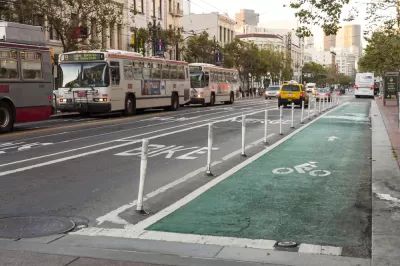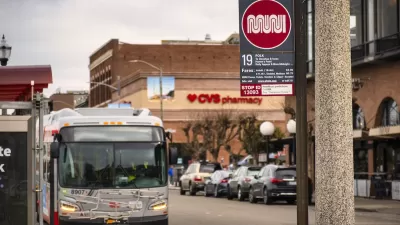Despite a stated goal of encouraging other modes, the city's streets still overwhelmingly prioritize cars.

Almost a half century after San Francisco first passed its "Transit-First" policy, writes Dan Federman, "less than 5 percent of [the city's] limited road space actually prioritizes transit."
To assess the way San Francisco uses its street space, Federman calculates the lane miles on San Francisco's streets, roughly 5,593.6 lane miles. "In 2019, SFMTA published a blog post saying that the city had painted 43 miles of transit-only lanes. Then in 2021 SFMTA announced that it was attempting to make 20 miles of recently created temporary transit-only lanes permanent," for a total of 63 permanent transit-only lanes. SFMTA has also "declared a goal of creating 45 lane-miles of protected bike lanes by 2021. Let’s give SFMTA the benefit of the doubt and assume that the city achieved its goal."
Federman concludes that "[i]n total, only 210.8 lane-miles prioritize alternatives to travel by private automobile in San Francisco. The remaining 5,382.8 lane-miles of road prioritize cars. In other words, more than 95 percent of our roads prioritizes cars," belying the city's stated goal to "encourage the use of public rights of way by pedestrians, bicyclists, and public transit."
FULL STORY: What Happened to “Transit First?”

Alabama: Trump Terminates Settlements for Black Communities Harmed By Raw Sewage
Trump deemed the landmark civil rights agreement “illegal DEI and environmental justice policy.”

Study: Maui’s Plan to Convert Vacation Rentals to Long-Term Housing Could Cause Nearly $1 Billion Economic Loss
The plan would reduce visitor accommodation by 25% resulting in 1,900 jobs lost.

Why Should We Subsidize Public Transportation?
Many public transit agencies face financial stress due to rising costs, declining fare revenue, and declining subsidies. Transit advocates must provide a strong business case for increasing public transit funding.

Paris Bike Boom Leads to Steep Drop in Air Pollution
The French city’s air quality has improved dramatically in the past 20 years, coinciding with a growth in cycling.

Why Housing Costs More to Build in California Than in Texas
Hard costs like labor and materials combined with ‘soft’ costs such as permitting make building in the San Francisco Bay Area almost three times as costly as in Texas cities.

San Diego County Sees a Rise in Urban Coyotes
San Diego County experiences a rise in urban coyotes, as sightings become prevalent throughout its urban neighbourhoods and surrounding areas.
Urban Design for Planners 1: Software Tools
This six-course series explores essential urban design concepts using open source software and equips planners with the tools they need to participate fully in the urban design process.
Planning for Universal Design
Learn the tools for implementing Universal Design in planning regulations.
Smith Gee Studio
Alamo Area Metropolitan Planning Organization
City of Santa Clarita
Institute for Housing and Urban Development Studies (IHS)
City of Grandview
Harvard GSD Executive Education
Toledo-Lucas County Plan Commissions
Salt Lake City
NYU Wagner Graduate School of Public Service





























